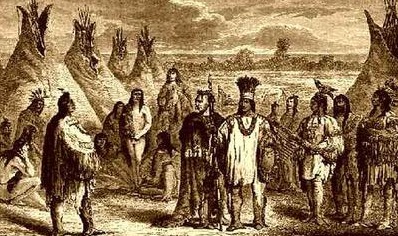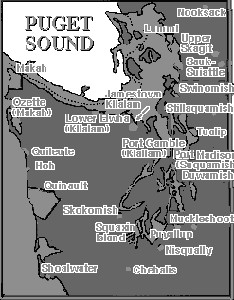
Echoes of the Evergreen Frontier: The Enduring Legend of the Puget Sound War
America is a tapestry woven with legends – tales of larger-than-life figures, heroic struggles, and foundational moments that shape our national identity. While some legends are born of myth and folklore, others emerge from the crucible of history, their truths sometimes obscured, sometimes amplified, but always resonant. Among these historical legends, often overlooked in the broader national narrative, is the Puget Sound War of 1855-1856 in Washington Territory – a conflict whose echoes still reverberate through the landscape and the collective memory of the Pacific Northwest, embodying both the promise and the peril of America’s westward expansion.
This wasn’t a war of distant armies clashing on open fields, but a brutal, intimate struggle for land, survival, and sovereignty, fought in the dense forests and along the winding waterways of what is now Western Washington. It was a clash ignited by the relentless tide of Manifest Destiny, personified by ambitious territorial officials, and met with desperate resistance by Indigenous peoples fighting for their ancestral homes. At its heart lies a legend of betrayal, a quest for justice, and the enduring power of a story that continues to challenge our understanding of American history.
The Inexorable March West: Seeds of Conflict

By the mid-19th century, the Pacific Northwest was no longer a remote wilderness but a burgeoning frontier. The Oregon Trail had deposited thousands of eager settlers, lured by the promise of fertile land and new beginnings. In 1853, the Washington Territory was carved out, and with it came its first governor, Isaac Ingalls Stevens. A man of formidable energy and ambition, Stevens was tasked not only with establishing a territorial government but also with extinguishing Indigenous land claims to pave the way for further settlement, railroad expansion, and economic development.
Stevens wasted no time. Driven by a mandate from Washington D.C. and his own unshakeable belief in American progress, he embarked on a whirlwind tour of treaty councils. Between 1854 and 1855, he negotiated an astonishing series of treaties – Medicine Creek, Point Elliott, Point No Point, Neah Bay, and Walla Walla – with numerous tribes, including the Nisqually, Puyallup, Muckleshoot, Suquamish, Skokomish, and many others. These treaties, often conducted rapidly and with significant linguistic and cultural barriers, promised small reservations in exchange for vast tracts of ancestral lands.
The problem, however, was in the translation and understanding. While Stevens and his commissioners believed they were securing absolute title to the land, many tribal leaders understood the agreements differently. To them, "selling" land was an alien concept; they believed they were agreeing to share resources and maintain traditional hunting and fishing rights, as was their custom. Furthermore, the designated reservations were often small, geographically undesirable, and far removed from traditional hunting and fishing grounds vital for survival. The Nisqually, for example, were initially assigned a reservation on an arid prairie, far from the river that was the lifeblood of their culture and economy.
As Chief Leschi of the Nisqually tribe, a pivotal figure in the ensuing conflict, later recounted through an interpreter, the treaties were "a great wrong." He and other chiefs, like Chief Quiemuth (Leschi’s brother) and Chief Kitsap, saw their people’s way of life threatened with extinction. The promises of annuities, schools, and blacksmiths seemed a poor substitute for self-determination and the vast territories they had stewarded for millennia.
The Spark Ignites: From Diplomacy to Bloodshed
The treaties, rather than bringing peace, stoked resentment. Settlers, emboldened by what they believed were legally secured land rights, encroached further onto traditional Indigenous territories. Gold discoveries in the interior further exacerbated tensions, bringing more prospectors through tribal lands. Isolated incidents of violence – cattle theft, retaliatory killings, and settler encroachments – began to escalate.
In the fall of 1855, the situation reached a boiling point. Frustrated by the lack of enforcement of treaty promises and the continued influx of settlers, a coalition of tribes, including the Nisqually, Puyallup, Muckleshoot, and Klickitat, led by figures like Leschi and Quiemuth, decided to resist. The immediate catalyst for the outbreak of open warfare is often attributed to a series of killings near the White River, where settlers were attacked. Governor Stevens, already in the midst of negotiating the Walla Walla Treaty with tribes further east, returned to a territory gripped by panic.
Stevens declared martial law in certain areas, raised volunteer militias, and immediately branded the Indigenous resistance an "Indian uprising." The narrative was simple: savage natives were attacking innocent settlers, and it was the government’s duty to protect its citizens and uphold the law. This narrative, however, glossed over the broken promises and legitimate grievances that fueled the conflict.

The War in the Woods: A Brutal Conflict
The Puget Sound War was not fought with grand strategies or massive armies. It was a series of skirmishes, ambushes, and retaliatory raids in the dense, unforgiving terrain of the Pacific Northwest. Militia groups, often ill-disciplined and driven by fear and vengeance, hunted down Indigenous families, sometimes indiscriminately. The U.S. Army, under Colonel George Wright, also played a role, but the brunt of the fighting often fell to the local volunteers.
Indigenous warriors, utilizing their intimate knowledge of the land, employed guerrilla tactics, striking quickly and then melting back into the forests. Their objective was often to disrupt settler expansion and to protect their families and remaining resources, rather than to conquer territory.
One of the most famous incidents of the war was the "Battle of Seattle" in January 1856. While often romanticized as a heroic defense of the nascent city, it was primarily a bombardment of Indigenous positions by the U.S. Navy sloop-of-war Decatur, with limited actual combat on land. The tribes, lacking the firepower to counter the naval vessel, eventually withdrew. This event, however, solidified in the settler consciousness the idea of a heroic stand against a savage enemy.
The Legend of Leschi: Martyr and Symbol
Central to the legend of the Puget Sound War is Chief Leschi. A leader of the Nisqually, Leschi initially signed the Treaty of Medicine Creek, but upon realizing the devastating implications for his people, he refused to move to the assigned prairie reservation. He sought to negotiate a better deal, traveling to Olympia to plead his case, but his appeals were ignored. When war broke out, he emerged as a prominent leader of the resistance, fighting to defend his people’s way of life.
Leschi became a primary target for Governor Stevens, who issued a warrant for his arrest and labeled him a murderer. After the war began to wind down, Leschi eventually surrendered in late 1856, hoping for a fair trial. What followed was a legal saga that exposed the deep racial prejudices of the time.
Leschi was accused of murdering Colonel A. Benton Moses, a volunteer militiaman. His first trial in January 1857 resulted in a hung jury, with some jurors arguing that Leschi was a combatant in a legitimate war, not a criminal murderer. However, Stevens, determined to make an example of Leschi, ensured a second trial. This time, the jury found him guilty. Despite pleas for clemency from many, including even some settlers who respected Leschi’s character, Governor Stevens refused.
On February 19, 1858, Chief Leschi was hanged. His execution was a travesty of justice, seen by many as a political act rather than a legal one. He was, in essence, executed for leading his people in defense of their land during a declared war. His final words, as remembered by those present, were a testament to his innocence and his people’s cause.
For generations, Leschi was remembered by his people as a martyr, a man who sacrificed everything for the Nisqually. His story was passed down through oral tradition, a quiet legend of injustice in the face of overwhelming power.
Reckoning with the Past: Leschi’s Exoneration
The legend of Leschi, however, did not remain confined to oral tradition. In the late 20th and early 21st centuries, a growing movement, supported by historians, tribal leaders, and even descendants of those who served in the militias, sought to right the historical wrong. They argued that Leschi’s conviction was unjust, that he was a prisoner of war, and that his execution was a judicial murder.
This movement culminated in a landmark event. In 2004, the Washington State Historical Society’s "Historical Court of Inquiry" – a non-binding but symbolically powerful body – formally exonerated Chief Leschi, concluding that he had been "wrongfully hanged." This decision was a profound moment, not just for the Nisqually and other Indigenous peoples, but for the entire state of Washington. It acknowledged a painful truth and offered a measure of healing and recognition.
The Leschi Act of 2004, passed by the Washington State Legislature, further cemented this exoneration, stating that "Chief Leschi was at all times a combatant in a war with the United States." This act officially recognized him not as a criminal, but as a warrior defending his people, transforming his legend from a tale of injustice into one of rectified historical truth.
The Enduring Legend: More Than Just History
The Puget Sound War, through the story of Chief Leschi and the broader narrative of tribal resistance, stands as a powerful legend of America. It reminds us that "progress" often comes at a terrible cost, and that the legends we choose to tell – and those we choose to ignore – profoundly shape our understanding of who we are.
The landscape of Western Washington itself is imbued with these legends. The rivers, the mountains, the very soil, hold the memories of those who fought and died there. The names of tribes, now recognized and sovereign, are etched into the map: Nisqually, Puyallup, Muckleshoot, Suquamish. Their resilience, their cultural survival against immense odds, is a testament to the enduring strength of their spirit.
The legend of the Puget Sound War is a complex one, a mosaic of perspectives. For some, it remains a story of brave pioneers taming a wild frontier; for others, it is a stark reminder of colonial violence and broken treaties. But as the exoneration of Chief Leschi demonstrates, legends are not static. They evolve as new evidence emerges, as marginalized voices are finally heard, and as society grapples with its past.
In the evergreen forests and along the bustling shores of Puget Sound, the echoes of this forgotten war continue to resonate. It is a legend that compels us to look beyond simplistic narratives, to acknowledge the full complexity of our history, and to remember that the stories of struggle, resistance, and the quest for justice are as integral to the American experience as any tale of westward expansion. These are the legends that truly define us, challenging us to confront our past honestly and to build a more just future.


